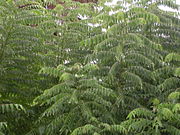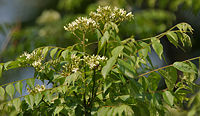Curry Tree
- For the "Curry Plant", see Helichrysum italicum. Kadipatta(Hindi) Karivepaku(Telugu) கறிவேப்பிலை(Tamil) or Sweet Neem leaf
- For the dish or sauce, see Curry.
| Curry Tree | ||||||||||||||||
|---|---|---|---|---|---|---|---|---|---|---|---|---|---|---|---|---|
 |
||||||||||||||||
| Scientific classification | ||||||||||||||||
|
||||||||||||||||
| Binomial name | ||||||||||||||||
| Murraya koenigii (L.) Sprengel[1] |
The Curry Tree or Kadipatta or Sweet Neem leaf.(Murraya koenigii; syn. Bergera koenigii, Chalcas koenigii) is a tropical to sub-tropical tree in the family Rutaceae, which is native to India.
Contents |
Description

It is a small tree, growing 4-6 m tall, with a trunk up to 40 cm diameter. The leaves are pinnate, with 11-21 leaflets, each leaflet 2-4 cm long and 1-2 cm broad. The flowers are small white, and fragrant. The small black, shiny berries are edible, but their seeds are poisonous.
The species name commemorates the botanist Johann Koenig.
Uses
Its leaves are highly aromatic and are used as a herb. Their form is small and narrow and they somewhat resemble the leaves of the Neem tree; therefore they are also referred to as Kari Baavu (translated to Black Neem) in the Kannada language and Karivepaku in Telugu, again translating to the same meaning. In Tamil and Malayalam it is known as Karuveppilai, ilai meaning leaves and veppilai meaning Neem leaf. Other names include Kari Patta (Hindi), noroxingha (Assamese), Bhursunga Patra (Oriya), Kadhi Patta (Marathi), Mithho Limdo (Gujarati) and Karapincha (Sinhalese).
They are commonly used as seasoning in Indian and Sri Lankan cooking, much like bay leaves and especially in curries with fish or coconut milk. In their fresh form, they have a short shelf life though they may be stored in a freezer for quite some time,though they lose much of flavour. They are also available dried, though the aroma is inferior.
Various biological activities of Murraya koenigii include antidiabetic[2], antioxidant[3], antimicrobial, anti-inflammatory, hepatoprotective, anti-hypercholesterolemic etc.,
References
- ↑ "Murraya koenigii information from NPGS/GRIN". www.ars-grin.gov. Retrieved on 2008-03-11.
- ↑ Arulselvan P, Senthilkumar GP, Sathish Kumar D, Subramanian S (Oct 2006). "Anti-diabetic effect of Murraya koenigii leaves on streptozotocin induced diabetic rats". Pharmazie 61 (10): 874–7. PMID 17069429.
- ↑ Arulselvan P, Subramanian SP (Jan 2007). "Beneficial effects of Murraya koenigii leaves on antioxidant defense system and ultra structural changes of pancreatic beta-cells in experimental diabetes in rats". Chem Biol Interact. 165 (2): 155–64. doi:. PMID 17188670.P.Arulselvan and S.Subramanian "antioxidant" page 155, Volume 165, Chemico-Biological Interactions, 2007